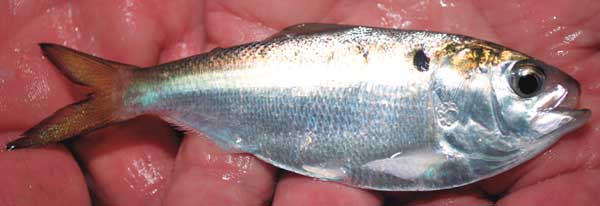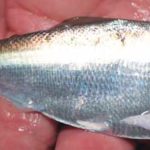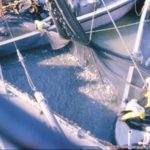
Menhaden, usually called pogies in Louisiana, are certainly not a game fish. They never bite a hook, even by accident. But sportsmen are well aware of them. The high oil content of their flesh makes them superb bait, and they are an important food source for virtually every predatory species of fish in their range.
Three species of menhaden are found in the Gulf of Mexico, the gulf menhaden in the northern Gulf, the finescale menhaden in the western Gulf and the yellowfin menhaden in the eastern Gulf. All are called pogies, and all have a silver body color and a large black spot on each side behind the head. The gulf menhaden also has a series of smaller spots behind the larger one that the other two species don’t have.
All gulf menhaden begin their lives between December and February in offshore waters. An average of 23,000 eggs are produced by each female. The eggs drift with water currents until they hatch, usually within 48 hours. The larvae, after hatching, are also helpless, drifting with the current. At their very early stages, they feed on large phytoplankton (microscopic floating plants).
As they grow larger and become able to swim, they shift their diet to zooplankters (microscopic floating animals). Finally, they lose their teeth and develop long, complex forward-pointing projections on each gill, called gill rakers, to strain their adult diet of plankton from the water. At this time also, the stomach develops into a gizzard.
While still in their planktonic stage, gulf menhaden larvae make their way into low-salinity estuaries for early growth. Whether this movement occurs only due to currents or whether some active swimming is involved is not known, but entry into estuaries is critical to their survival.
Once in an estuary and large enough to swim well, they frequently move into fresh water, often over 30 miles up rivers. In estuaries, they grow rapidly and by summer they move to higher-salinity waters. Migration offshore occurs later in the summer and in the fall.
After they move offshore, they seldom venture into waters deeper than 300 feet. Few, if any, gulf menhaden spawn their first winter, but almost all fish are mature by their second winter, when they are considered 1-year-old. Average size at the age is slightly over 5 inches long. Gulf menhaden will live to five and perhaps six years old, although the majority of fish in the population are age-one and age-two. A 5-year-old fish will average nearly 10 inches long.
The gulf menhaden provides the basis for Louisiana’s largest commercial fishery by weight. Although some of the catch is sold for bait used in recreational and other commercial fisheries, most of it is processed into oil, meal and solubles that have a wide range of uses.
Menhaden are commercially harvested with purse seines. These large nets are set with two small boats. When the school of fish is surrounded by the net, the bottom of the net is closed, or “pursed,” by drawing in a line through rings at the bottom of the net, leaving the fish school completely enclosed.
The set is then “hardened” by part of it being retrieved on the boat with a power block. When enough of the net is retrieved, the fish become densely concentrated in the part left in the water. They are then suction-pumped into the refrigerated hold of the mother ship.
Because of the size and efficiency of purse seines, some people assume that the fishery has a large amount of bycatch other than the menhaden and “herring-like” species that are the target of the fishery. In 1994-95, LSU scientists studying bycatch spent 51 weeks on board menhaden vessels sampling their catch.
Samples were taken from the fish being pumped into the hold of the vessel from purse seine sets, and all fish were identified, counted and weighed.
In 1994, 220 sets were sampled from sets averaging 92,438 menhaden. Sixty-five (29.5 percent) of the sets had no bycatch at all. One to three species of bycatch appeared in 127 sets (57.8 percent). Only 10 net sets (4.5 percent) had more than six species of bycatch. For the sake of this study, “herring-like” species such as Atlantic thread herring, Spanish sardines and scaled sardines were considered bycatch, even though they are usually considered part of the menhaden fishery.
By weight, bycatch species made up less than one percent (0.88 percent) of the catch in 1994. The top species of bycatch by weight were Atlantic croakers, sand (white) seatrout, silver seatrout, striped mullet and spot. These five species made up almost 79 percent of the bycatch by weight. Three speckled trout and three redfish appeared in the 220-net set samples.
In 1995, 199 purse seine sets were sampled, averaging 71,161 menhaden per set. Seventy-one (35.7 percent) of the sets had no bycatch. One of three bycatch species occurred in 88 sets (44 percent), while 14 sets (7.0 percent) had six or more species.
By weight, bycatch species made up 2.14 percent of the catch in 1995. The five most common species of bycatch by weight (not counting cabbagehead jellyfish) were Atlantic croaker, sand seatrout, gafftopsail catfish, spot and silver trout. The five species made up a little more than 75 percent of the weight of the bycatch.
No redfish and only one speckled trout occurred in the 1995 samples. It should be noted that in both years, numbers of larger fish were released rather than being pumped into the hold, and some fish were kept by menhaden boat crew members for their personal consumption.
During sampling, two green sea turtles were observed in the net in 1994, both of which were released healthy. In 1995, two loggerhead and one hawksbill turtle were observed. All were released alive.
Jerald Horst is an author of the Angler’s Guide to Fishes of the Gulf of Mexico, a 444-page, color-illustrated book on fishes written for saltwater fishermen. The book is available in better bookstores or can be ordered by calling 1-800-843-1724.




